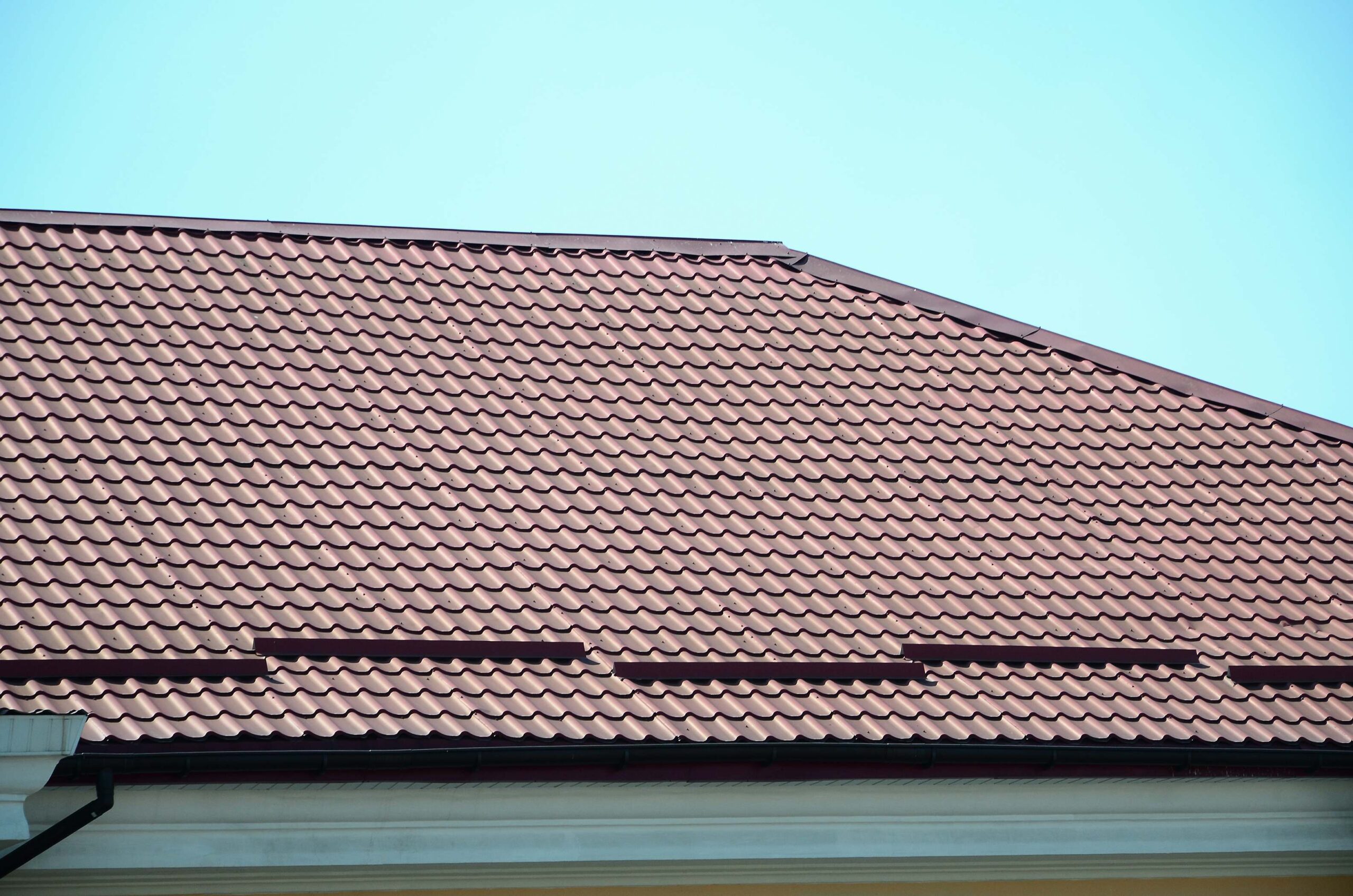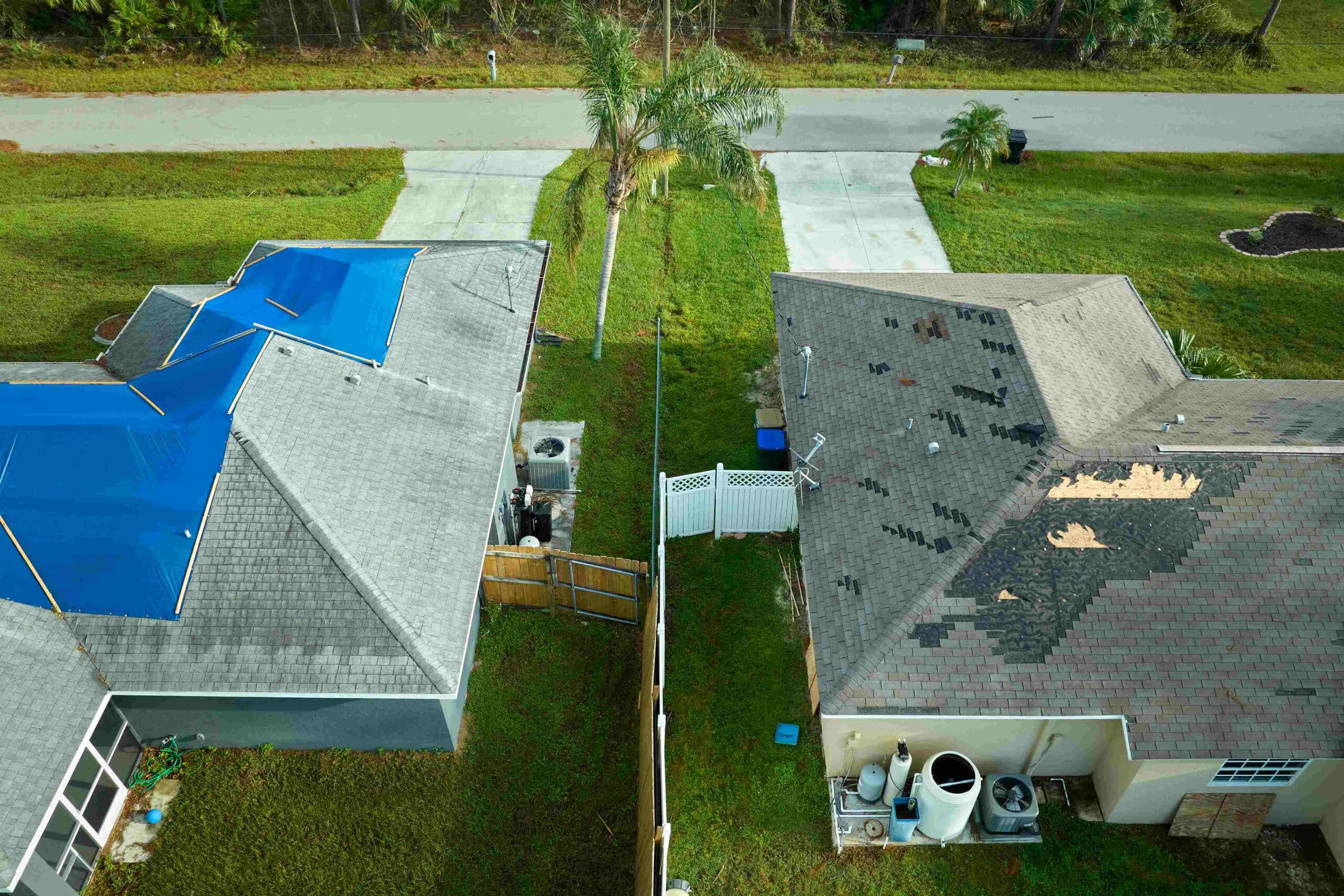All it takes is a sudden storm or an unfortunate mishap, and suddenly, you find yourself grappling with broken shingles and leaking roofs. We understand that emergencies like these call for swift and decisive action. That’s where our focus on urgent shingle replacement and roof damage repair come into play. With our emergency protocols – immediate leak tarping, re-securing of shingles, thorough damage documentation, and swift professional intervention — we are prepared to guide you through the process. Understanding when to employ do-it-yourself measures, and when to call in the experts, could be the difference between a swift fix and prolonged, costly damage to your home.
Key Takeaways
- Recognize the signs of roof damage: water leakage, missing or loose shingles, and mold growth
- Understanding when to undertake a Do-It-Yourself (DIY) repair versus when to call in professionals can save both time and money in the long run
- Act swiftly by implementing measures such as tarping the leak, re-securing loose shingles, and documenting the damage
- Consider reaching out to professionals who specialize in emergency roof restoration for the best results
- Maintaining the safety and integrity of your home is the ultimate priority during emergency roof situations
Understanding the Urgency of Shingle Roof Damage
In a homeowner’s life, roof emergencies can strike unexpectedly, leaving you grappling with how to maintain the safety and integrity of your home. Given the urgency of roof repair, understanding the signs of a roofing emergency, common triggers, and immediate actions to take is our focus for this section.
Common Triggers for Emergency Repairs
Various triggers necessitate immediate roof repair. These can range from severe weather causing water damage, to fire, wind storms, tree impacts, pest infestations, and even long-term neglect. Many home owners have lost countless dollars in property value and repair costs due to a lack of understanding concerning these triggers and their implications.
| Trigger | Description |
|---|---|
| Severe weather | Storms, hail, or high winds dislodge shingles and cause water leaks. |
| Fire | Heat can warp or melt shingles, leaving them ineffective as a cover. |
| Wind storms | Strong gusts or sustained winds can lift or tear away shingles. |
| Tree impacts | Fallen branches or other foliage can damage the roof surface, often puncturing shingles. |
| Pest infestations | Termites, rodents, or other pests can chew or gnaw through wood and shingles, creating openings. |
| Long-term neglect | Over time, without regular inspection and maintenance, minor damages can grow into significant issues. |
Identifying Types of Emergency Roof Damage
During our journey of exploring emergency roof repairs, one of the primary steps is understanding and identifying different types of shingle damage and potential roof integrity threats. The nature of the emergency roof damage in question can greatly influence appropriate remedies and repair techniques.
Damage on roofs can manifest in several ways, each carrying its own set of consequences and repair necessities. Familiarizing ourselves with these telltale indicators can go a long way in facilitating prompt and effective emergency roof damage identification which can be key in mitigating more severe damage and associated costs.
- Dents from Hail: One of the most common shingle damage types, usually visible in the form of round or oval indentations on shingles.
- Leaky or Soaked Shingles: Roof leaks can often lead to shingles becoming saturated or mouldy. In more severe cases, shingles may even break away from the roof, affecting its structural layout.
- Visible Light Through Roof Boards: A telltale sign of roof integrity threats is when light is visible through roof boards, signalling underlying damage or structural instability.
- Unexplained Increases in Energy Costs: Sudden and unexplained jumps in energy costs could indicate issues with roof insulation, possibly resulting from leaks or other roof damage.
- Sagging Gutters: Gutters begin to sag due to blockages, usually caused by debris accumulation. This can lead to water overflows or even damage the structure of the gutters themselves.
Recognizing these indicators promptly can play a crucial role in successfully averting escalating emergencies.
| Type of Damage | Potential Consequences | Typical Causes |
|---|---|---|
| Dents from Hail | Reduction in shingle lifespan | Severe hailstorm |
| Leaky or Soaked Shingles | Water damage, mould growth | Poor workmanship, natural wear and tear |
| Visible Light Through Roof Boards | Structural instability | Long-term neglect, inadequate fittings |
| Unexplained Increases in Energy Costs | Loss of home efficiency | Insulation issues due to leaks or damage |
| Sagging Gutters | Roof and siding damage | Blockages from leaves, twigs, or other debris |
Events such as storms, fires, pest invasions, or structural instability can swiftly convert these issues into full-blown emergencies that require immediate action. The faster we identify and respond to these warning signs, the better we can minimize roof damage, thus ensuring the safety and longevity of our homes.
Proactive Measures for Shingle Roof Longevity
As experienced roofers, we thoroughly understand the intricacies of roofs, and even more so, how critical their maintenance is to your home’s well-being. With our vast expertise, we will guide you through proper roof maintenance steps, seasonal roofing strategies, and the importance of swift response to minor damages. Each of these strategies plays a pivotal role in ensuring the longevity of your shingle roof.
Regular Inspection and Maintenance
Being proactive about regular inspections can dramatically extend your roof’s lifespan. Keep an eye out for accumulated debris, loose shingles, or mold growth. Depending on the severity, some of theses issues can be addressed immediately, while others may require professional attention. Either way, the principle remains the same – nipping minor issues in the bud before they exacerbate can be a significant step towards preventative roofing care.
Seasonal Roofing Precautions
Climate changes and seasonal weather transitions can take a toll on your roof’s health. Therefore, it’s essential to be strategically proactive during these periods. Before the onset of severe weather conditions, ensure your roof is prepared to withstand the challenges that come along. This includes clearing out your gutters and examining for any cracks or loose tiles that may pose as potential leak sources.
Importance of Timely Response to Minor Damages
Unresolved minor roof damage can rapidly worsen when neglected, leading to severe structural issues that demand costly emergency repair. Hence, a timely response to minor damages isn’t just about maintaining your roof’s aesthetic appeal but more about securing its structural integrity. Incidentally, consistent preventative roofing care can save you from hefty repair bills in the long run.
| Maintenance Strategy | Description | Benefits |
|---|---|---|
| Regular Inspection and Maintenance | This includes cleaning debris off your roof and checking for minor issues like loose shingles or mold growth. | Regular inspections can identify issues while they’re still minor, saving you from costly repairs down the line. |
| Seasonal Roofing Precautions | Before the onset of severe weather conditions, ensure your roof is prepared to withstand the challenges. This could include cleaning gutters or checking for cracks. | Proactively preparing your roof for seasonal weather changes can prevent unforeseen damage and extend your roof’s lifespan. |
| Timely Response to Minor Damages | Immediately addressing small issues as they arise can prevent them from becoming major problems. | A timely response to minor damages saves you money in the long term by preventing the need for extensive repairs. |
In conclusion, shingle roof longevity can be substantially influenced by consistent roof maintenance, the implementation of appropriate seasonal roofing strategies, and quick response to minor damages. As such, always remember that an ounce of prevention will always be worth more than a pound of cure, especially when it comes to maintaining your roof’s integrity.
When to Call the Professionals for Roof Repair
Roof damage, no matter how small, can rapidly escalate into an emergency if not addressed promptly. While DIY methods provide temporary relief, they’re far from a permanent solution. Tackling significant damages such as missing flashing or structural issues necessitates professional intervention. Let’s delve into why and when you should engage professional roof repair services and the role of insurance in the process.
Limitations of DIY Repair Techniques
DIY methods, although sometimes cost-effective and seemingly straightforward, have their limitations. Handling delicate components of your roof without proper training can lead to ineffective repairs or even additional damage. Moreover, activities like climbing onto your roof or handling heavy materials can be hazardous without proper safety measures. Therefore, for any significant roof damage, engaging the services of qualified roofers is always the safer, more effective choice.
The Role of Insurance in Roof Repairs
Understanding roof insurance claims is another essential part of the repair process. If your roof damage is covered under your homeowners’ insurance policy, a claim can significantly reduce the out-of-pocket costs of repairs. Ensure to document the damage extensively and maintain good communication with your insurance provider throughout the process. Comply with all their requirements to facilitate a hassle-free claim.
Whenever encountering roof problems, remember that professional repairs not only address the present issue but also reduce the chances of future complications. With skilled roofers at your service and the right understanding of your insurance policy, achieving a thoroughly repaired and lasting roof is within reach.
| Steps to Engaging Professional Roof Repair |
|---|
| 1. Recognize the limitations of DIY methods and the need for professional help |
| 2. Vet potential roofers, checking their credentials and reviews |
| 3. Book a repair session with your chosen contractor |
| 4. Document the damage for potential insurance claims |
| 5. Communicate with your insurance provider and comply with all requirements |
Conclusion
In the wake of a roofing emergency, homeowners must act decisively to preserve their property. We’ve outlined key strategies for tackling sudden shingle damage, emphasizing the importance of quick action, informed DIY methods, and judicious hiring of professional help. Our emergency roof repair summary is a comprehensive guide to dealing with these situations, helping you protect your property effectively.
Damage identification and immediate mitigation go hand-in-hand. Stop-gap measures like tarping a leak or resecuring a loose shingle can help you stem the tide in an emergency. However, these are temporary solutions only, and we highly recommend calling in a professional roofing service as quickly as possible for a comprehensive repair.
Above all, remember that your roof’s longevity ties directly into how well you maintain it. Do not neglect regular maintenance or forego precautionary measures. Be proactive with inspections and attend to minor damages in a timely manner. At the end of the day, it’s not just about managing emergencies but preventing them in the first place.
We’ll leave you with one final thought— roofing emergencies may seem daunting, but with some foresight, informed decision-making, and proactive measures, you can effectively safeguard your home. Keep our final thoughts on shingle protection in mind as you navigate the process. You’ve earned this knowledge. Now, put it to good use and remember safety and maintenance are paramount.
At Eustis Roofing, we’re here to personally guide you through top-notch roofing services in Mount Dora, FL. Let’s connect today and begin your journey towards transforming your roof.



